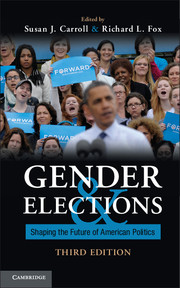Book contents
- Frontmatter
- Contents
- List of Figures, Text Boxes, and Photos
- List of Tables
- Contributors
- Acknowledgments
- Introduction
- 1 Presidential Elections
- 2 Cracking the “Highest, Hardest Glass Ceiling”
- 3 Voter Participation and Turnout
- 4 Voting Choices
- 5 Latinas and Electoral Politics
- 6 African-American Women and Electoral Politics
- 7 Congressional Elections
- 8 Political Parties and Women's Organizations
- 9 Advertising, Websites, and Media Coverage
- 10 Women's Election to Office in the Fifty States
- Index
- References
Introduction
Gender and Electoral Politics in the Twenty-First Century
Published online by Cambridge University Press: 05 June 2014
- Frontmatter
- Contents
- List of Figures, Text Boxes, and Photos
- List of Tables
- Contributors
- Acknowledgments
- Introduction
- 1 Presidential Elections
- 2 Cracking the “Highest, Hardest Glass Ceiling”
- 3 Voter Participation and Turnout
- 4 Voting Choices
- 5 Latinas and Electoral Politics
- 6 African-American Women and Electoral Politics
- 7 Congressional Elections
- 8 Political Parties and Women's Organizations
- 9 Advertising, Websites, and Media Coverage
- 10 Women's Election to Office in the Fifty States
- Index
- References
Summary
With unemployment hovering above 8 percent and a burgeoning national debt, the economy was the central policy issue of the 2012 presidential election. But the battle for female voters, attention to “women's issues,” and the question of which party better understood the needs, values, and experiences of women also garnered substantial attention. Never before had women voters received so much media attention in a general election. A Lexis-Nexis search of major news publications found about three times more mentions of “women voters” in the context of the 2012 presidential election than in any prior election. The attention placed on women voters and “women's issues” appeared to have a significant influence on the outcome in 2012, an election that featured one of the largest gender gaps ever in presidential voting. Women favored President Obama by a margin of 55 percent to 44 percent, whereas men favored former Massachusetts governor Mitt Romney by a margin of 52 percent to 45 percent. The 10-point difference in the proportions of women and men voting for Obama represents the second-largest gender gap in U.S. history, just slightly smaller than the 11 point gender gap in voting for Bill Clinton in 1996.
Gender began to play an important role in the 2012 election long before the final votes were counted. In fact, the Democrats started to characterize the Republicans as engaging in a “war on women” months before Mitt Romney became the official GOP nominee. The “war on women” narrative came about and caught hold because of a series of remarks made by prominent Republicans. A prolonged and hotly contested Republican presidential primary race among several strongly conservative candidates who sometimes expressed extreme views provided initial material for the Democrats to exploit, and a series of comments by Republican U.S. Senate and House candidates fueled the “war on women” narrative throughout the fall of 2012.
- Type
- Chapter
- Information
- Gender and ElectionsShaping the Future of American Politics, pp. 1 - 15Publisher: Cambridge University PressPrint publication year: 2013
References
- 1
- Cited by



